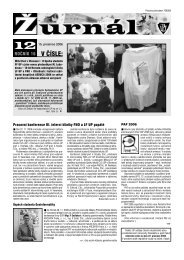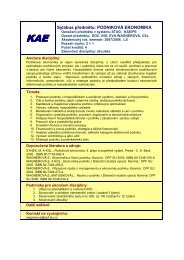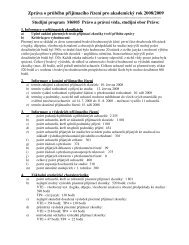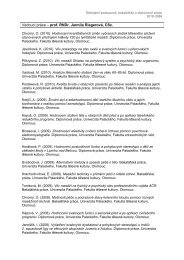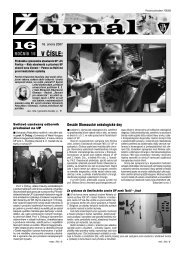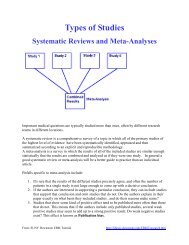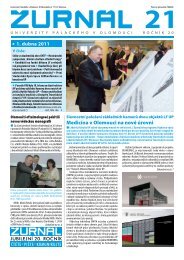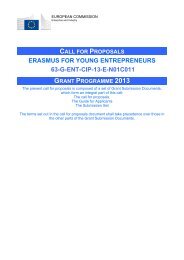68 Acta Univ. Palacki. Olomuc., Gymn. 2004, vol. 34, no. 2TABLE 1General characteristics of the research subjectsSex N Age [years] AgeLevel of mental retardation[x] mild moderate severe10 11 12 13 14 15 16 N % N % N %Girls 21 0 1 4 8 2 4 2 13.47 1 4.76 15 71.42 5 21.80Boys 28 1 4 6 3 7 3 4 13.46 1 3.57 23 82.14 4 14.2821 girls and 28 boys. This group was subdivided intothree subgroups. The 1 st subgroup comprised thosewith a mild level of mental retardation; the 2 nd subgroup– those with a moderate level; the 3 rd subgroup – thosewith a severe level of mental retardation (TABLE 1).Some of the children also have various dysfunctions intheir motor organs (scoliosis, paraplegia, hemiplegia,torticollis, club-foot), but in most cases (85.7%) mentalretardation was the only observed dysfunction (TABLE 2).TABLE 2Dysfunctions in motor organsSexMental retardationWith dysfunctions Without dysfunctionsN % N %Girls 5 23.8 16 76.2Boys 2 7.1 26 92.9The Special School and Upbringing Centre inMrowla near Rzeszów can ensure good conditions forhelping children to achieve suitable motor skills comparableto those of others. There are two halls: one gymand one for correction exercise, and two fields: one forsport and one for recreation where physical educationtraining is held 3–4 times a week and corrective gymtraining is also held (4 hours per week). Children alsohave the opportunity to participate in training in theswimming pool 2 hours per week. All examined childrenattend sporting exercises that improve their motor skills(Momola & Marszałek, 1997).The examinations were carried out in the correctionexercise gym, separately for each individual child. Theexamination was interrupted in case of the physical ormental tiredness of a given child.Tests of motor ability were prepared according tothe Ozierecki method with a Barański modification. Theexercise set for a given calendar age, from 4–16 years ofage, included 6 groups of different motor tasks:– static co-ordination,– dynamic co-ordination,– hand co-ordination,– movement speed,– simultaneous movement performance,– movement precision.The set of tests was held separately in each group.The number of tasks is large and their level of difficultiesincreases with age and that makes the comparisonbetween age groups difficult and the examination timeconsuming.The evaluation is based on pointing out the agegroup in which the child completes all tasks and thosein which the child doesn’t complete any of them. Thusthe range of “motor ability” can be estimated and lateron–according to special rules – the “motor ability age”can be estimated. Based on the Barański classificationone can say whether the child is at a normal level ofdevelopment, backwardness or precociousness in comparisonwith the whole population.The basis for starting the test is estimation of a registeredcalendar age – that is the difference between thedate of research and the date of birth. The next step is– knowing the motor ability age and basis for conductedtasks – an estimation of the difference between the registeredand motor ability age that lets us classify the childinto one of the following categories:– precociousness [+D, +C, +B, +A],– backwardness [–A, –B, –C, –D],– the norm [0].The norm of motor skills is the difference betweenthe registered calendar age and the motor ability ageand varies from 0 to +18 months. In case the differenceis greater than +18 months, motor skills are classifiedat the precocious development level. In case the differenceis below 0 one can say that this is backwardness ofmotor skills (Barański, 1963; Olszowski, 1973; Szopa,Mleczko, & Żak, 1996).RESEARCH RESULTS AND DISCUSSIONOn the basis of the examinations conducted, themotor skills index in the 1 st subgroup was determinedto amount to –24 months in a girl, and –60 months ina boy. It must be mentioned that the boy’s result mayhave been influenced by his excessive obesity (his bodyweight was 96 kg at the body height of 145 cm).The 2 nd subgroup, in which 71% of the girls werecharacterised by a moderate degree of mental retardation,showed the average motor skills index of –57months. The participation of boys in this group was
Acta Univ. Palacki. Olomuc., Gymn. 2004, vol. 34, no. 2 69TABLE 3Results of research on motor skills of children with mental retardation (according to Baranski)SexLevelof NCalendarageMotor skilldevelopmentLevel of motorSymbolmental retardation[x] index–MSDI*[months]skill developmentMild 1 12.00 –24 Moderate level of retardation –BGirls Moderate 15 13.73 –57 Very high level of retardation –DSevere 1 11.00 –72 Very high level of retardation –D4 13.50 – Measureless –Mild 1 13.00 –60 Very high level of retardation –DBoys Moderate 23 13.69 –51 Very high level of retardation –DSevere 4 12.25 – Measureless –MSDI – the difference between motor skills age and calendar agegreater by 11.72%, whereas the average index amountedto –51 months.The 3 rd group consisted of seriously impaired children,including 21% girls and 14% boys. In this group,only one girl managed to complete a test for 5-year-olds,and single tasks for 6-, 7-, and 8-year-olds. The motorskills index for this child was –72 months. The otherchildren in this subgroup were able to complete onlysingle motion tasks in a test, hence they did not reachthe level of the motor skills development characteristicof a 4-year-old child (TABLE 3).An analysis of the degree of acceleration or retardationof motor skills in more seriously impaired childrenpoints to a very high level of retardation. In light of theresults obtained, the requirements of the Ozierecki scaleseem to be too difficult for children with a substantiallevel of mental incapacity.Moreover, the research results served the purpose ofdetermination of the difficulty degree while performingrespective tests. The easiest of the tests proved to be Test2, evaluating dynamic hand co-ordination. The secondeasiest was Test 1, evaluating static co-ordination. Test3, evaluating the level of whole body co-ordination,proved to be more difficult. The most difficult tasks tocomplete of those required were, consecutively, the following:Test 4, evaluating the speed of movements, Test5, of simultaneous movement performance, and Test6, which evaluated movement precision. The obtaineddegree of difficulty in performing the tests points to thenecessity for more lax requirements while performingtasks for the purpose of the assessment of precisionand speed of movements, as well as simultaneous movementperformance. The above-mentioned observationsconcerning the degree of the difficulty of respective testsprove the results of the research by Eider (1988).Examinations – with the use of the Ozierecki test, asmodified by Barański – of the motor skills in childrenwith neurotic disorders, were conducted by Mleczkowskaand Frańczak (1968). They claim that 28 % of thechildren examined showed retardation of motor skillsdevelopment.The level of physical development of children witha partial loss of sight was studied by Pielecki (1994). Accelerationof motor skills development was not found inthose children. The majority of the children were characterisedby a moderate level of motor skills retardation,whereas the least frequent disorders were those of movementprecision, in contrast to the examination resultsobtained in more seriously impaired children.CONCLUSIONS1. The Ozierecki scale offers a very high degree of difficultyfor children with substantial mental retardation.2. Despite the difficulties in performing the test, motorskills in children with slight mental incapacityshould be developed.3. Children with a substantial mental disability showa very high level of motor skills retardation. In thisgroup, the most disturbed are movement precisionand speed, as well as the ability to perform simultaneousmovements.REFERENCESBarański, A. (1963). Charakterystyka zdolności ruchowychdzieci ośmioletnich na podstawie badań testowych.Rozprawy Naukowe WSWF Wrocław, 2.Clarke, A. M., & Clarke, A. D. B. (1971). Upośledzeniaumysłowe. Warszawa: PWN.
- Page 1 and 2:
ACTAUNIVERSITATIS PALACKIANAE OLOMU
- Page 3 and 4:
ACTAUNIVERSITATIS PALACKIANAE OLOMU
- Page 5:
Acta Univ. Palacki. Olomuc., Gymn.
- Page 8 and 9:
8 Acta Univ. Palacki. Olomuc., Gymn
- Page 10 and 11:
10 Acta Univ. Palacki. Olomuc., Gym
- Page 12 and 13:
12 Acta Univ. Palacki. Olomuc., Gym
- Page 14:
14 Acta Univ. Palacki. Olomuc., Gym
- Page 17: Acta Univ. Palacki. Olomuc., Gymn.
- Page 20 and 21: 20 Acta Univ. Palacki. Olomuc., Gym
- Page 22: 22 Acta Univ. Palacki. Olomuc., Gym
- Page 26 and 27: 26 Acta Univ. Palacki. Olomuc., Gym
- Page 28 and 29: 28 Acta Univ. Palacki. Olomuc., Gym
- Page 32 and 33: 32 Acta Univ. Palacki. Olomuc., Gym
- Page 34 and 35: 34 Acta Univ. Palacki. Olomuc., Gym
- Page 36 and 37: 36 Acta Univ. Palacki. Olomuc., Gym
- Page 38 and 39: 38 Acta Univ. Palacki. Olomuc., Gym
- Page 40 and 41: 40 Acta Univ. Palacki. Olomuc., Gym
- Page 43 and 44: Acta Univ. Palacki. Olomuc., Gymn.
- Page 45 and 46: Acta Univ. Palacki. Olomuc., Gymn.
- Page 47 and 48: Acta Univ. Palacki. Olomuc., Gymn.
- Page 49 and 50: Acta Univ. Palacki. Olomuc., Gymn.
- Page 51 and 52: Acta Univ. Palacki. Olomuc., Gymn.
- Page 53 and 54: Acta Univ. Palacki. Olomuc., Gymn.
- Page 55 and 56: Acta Univ. Palacki. Olomuc., Gymn.
- Page 57 and 58: Acta Univ. Palacki. Olomuc., Gymn.
- Page 59: Acta Univ. Palacki. Olomuc., Gymn.
- Page 62 and 63: 62 Acta Univ. Palacki. Olomuc., Gym
- Page 64 and 65: 64 Acta Univ. Palacki. Olomuc., Gym
- Page 66 and 67: 66 Acta Univ. Palacki. Olomuc., Gym
- Page 70 and 71: 70 Acta Univ. Palacki. Olomuc., Gym
- Page 72 and 73: 72 Acta Univ. Palacki. Olomuc., Gym
- Page 74 and 75: 74 Acta Univ. Palacki. Olomuc., Gym
- Page 76 and 77: 76 Acta Univ. Palacki. Olomuc., Gym
- Page 78 and 79: ACTAUNIVERSITATIS PALACKIANAE OLOMU




